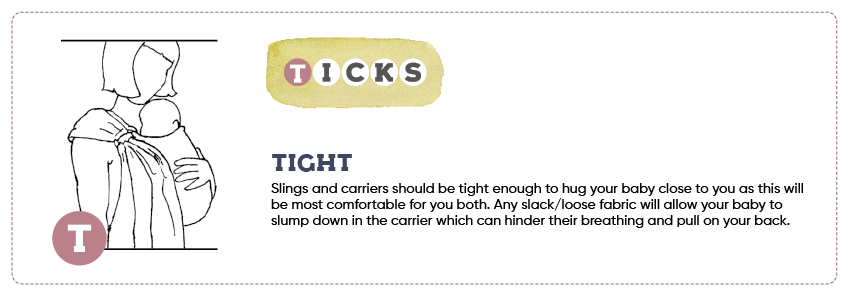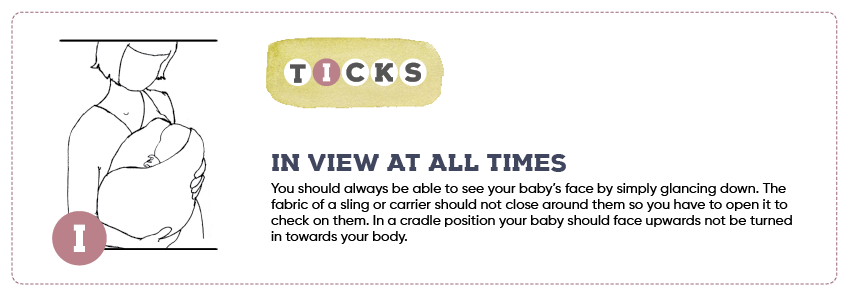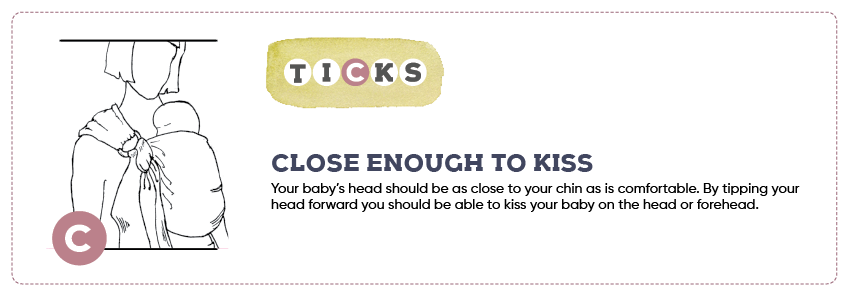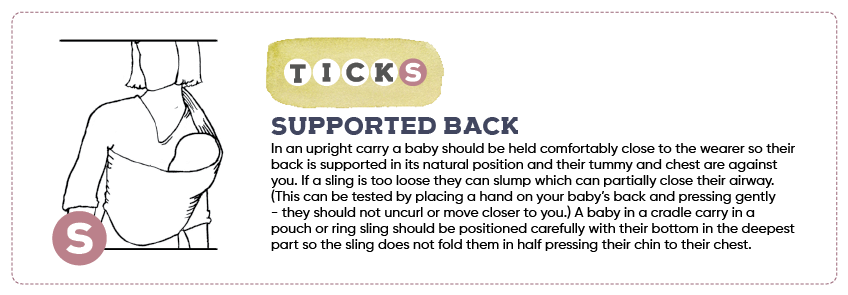Babywearing is a cherished practice that fosters a deep connection between you and your little one, all while granting you the freedom to navigate daily tasks. To ensure this experience remains safe and enjoyable, let’s delve into some essential guidelines that will help you and your baby make the most of babywearing.
General Safety Tips
- Upright Positioning: Always carry your baby in an upright position. Avoid using slings in a lying-down cradle position, as this can compromise your baby’s airway.
- Support When Bending: When bending over, always support your baby with one hand to prevent any risk of falling. Carriers are not designed to secure your baby during such movements without additional support.
- Regular Inspection: Periodically inspect your carrier for signs of wear and tear, such as ripped seams, sharp edges, or loose buckles. Ensuring your carrier is in good condition is vital for your baby’s safety.
Dressing Your Baby for Babywearing
- Layering: Consider the carrier as one layer of clothing. Dress your baby accordingly to prevent overheating or getting too cold. Merino layers are recommended for their breathability and warmth.
- Avoiding Puffy Clothing: Refrain from dressing your baby in puffy jackets while in the carrier. Bulky clothing can prevent the carrier from being tightened properly, posing a fall risk.
- Never Cover Baby’s Face: It can be a great idea to add another layer outside the carrier, like a babywearing jacket, which can be removed easily if the weather changes, but we always recommend that baby’s face is clear of any fabrics to ensure air flow.

The T.I.C.K.S. Rule for Safe Babywearing
When it comes to keeping your baby secure in a carrier, the T.I.C.K.S. rule is your go-to checklist:
- Tight: Ensure the carrier hugs your baby snugly against your body. A firm fit prevents unnecessary movement, keeping your baby in a safe position.
- In View at All Times: Your baby’s face should always be visible without needing to adjust the carrier or your clothing. This constant visibility allows you to monitor their well-being effortlessly.
- Close Enough to Kiss: Position your baby so that their head is close enough for you to plant a gentle kiss on their forehead or the top of their head. This proximity not only enhances bonding but also ensures they’re at a safe height.
- Keep Chin Off the Chest: Make sure there’s enough space (about two fingers’ worth) under your baby’s chin. This prevents their chin from pressing against their chest, which could restrict breathing.
- Supported Back: Your baby’s back should be well-supported in a natural position. If you place a gentle hand on their back, they shouldn’t slump or curl; instead, they should remain comfortably upright.
Click on the arrows to scroll through.
Achieving the ‘M’ Position with a Pelvic Tuck
Proper positioning is key to your baby’s comfort and development. The ‘M’ position, achieved through a pelvic tuck, supports healthy hip development:
- Pelvic Tuck: Gently tilt your baby’s pelvis so that their bottom scoops inward, encouraging their spine to adopt a natural curve.
- Knees Higher than Bottom: In this position, your baby’s knees should be slightly higher than their bottom, forming the shape of the letter ‘M’ with their legs. This alignment supports their hips and spine optimally.
This ergonomic posture is especially important for preventing hip dysplasia and ensuring your baby’s comfort during extended periods in the carrier.
Selecting a Safe and Optimal Carrier
Choosing the right carrier can make all the difference in your babywearing journey. Here’s what to consider:
- Head and Neck Support: For newborns, it’s crucial that the carrier provides adequate support to their head and neck, as they haven’t yet developed the strength to hold their heads up independently.
- Ergonomic Design: opt for carriers that promote the ‘M’ position, ensuring your baby’s knees are elevated above their bottom. This design supports healthy hip development.
- Breathable Materials: Select carriers made from durable, breathable fabrics to maintain a comfortable temperature for both you and your baby.
- Adjustability: An optimal carrier offers adjustable straps and settings, allowing you to customize the fit as your baby grows and as different caregivers use it.
- Safety Standards: While New Zealand doesn’t have specific safety standards for baby carriers, it’s advisable to select carriers that meet either US or EU safety standards. This ensures the carrier has undergone rigorous testing for safety and durability.
- Avoid Counterfeit Products: Be cautious of counterfeit carriers, especially when purchasing from online marketplaces. Authentic carriers from reputable retailers maintain consistent pricing. If a deal seems too good to be true, it might be a fake. Always verify the authenticity to ensure safety.
Keeping Your Baby’s Face Uncovered
It’s vital to ensure your baby’s face remains uncovered while in the carrier:
- Airflow: Covering your baby’s face with fabric or clothing can restrict airflow, posing a suffocation risk. Always ensure their nose and mouth are exposed to fresh air.
- Visibility: Keeping your baby’s face visible allows you to monitor their expressions and breathing, ensuring they’re comfortable and safe.
- Hood Usage: If your carrier has a hood for sun or wind protection, ensure it’s made of lightweight, breathable material and doesn’t obstruct your baby’s face.
Outward-Facing Carry: Benefits and Duration
As your baby grows and becomes more curious about the world, you might consider an outward-facing carry:
- Age Consideration: It’s generally recommended to wait until your baby has strong head and neck control and is able to tripod sit this is typically around 6 months but can be later. If you have a very curious baby and they are not able to tripod sit yet you could also look at a hip carry, you can achieve excellent optimal position in a ring sling.
- Benefits:
- Exploration: Allows your baby to engage with their environment, satisfying their growing curiosity.
- Social Interaction: Facilitates interaction with others, which can be stimulating and enjoyable for your baby.
- Duration: Limit outward-facing sessions to 15 to 20 minutes to prevent overstimulation. Always pay attention to your baby’s cues; if they seem uncomfortable or tired, switch back to an inward-facing position.
- NEVER LET YOUR BABY SLEEP WHILE OUTWARDS-FACING: Babies should not sleep while facing outwards in a carrier because their head can slump forward, restricting their airway and making it harder for them to breathe safely.
Transitioning to Back Carrying
As your baby continues to develop, you might consider carrying them on your back:
- Readiness: Most babies are ready for back carrying once they have full head and upper body control and can sit unassisted, usually around 6 months.
- Carrier Type: Ensure your carrier is designed for back carrying and that you’re comfortable with the positioning process.
- Safety First: Always follow the manufacturer’s instructions and practice the back carry with assistance or over a soft surface until you feel confident.
By embracing these guidelines, you’re setting the foundation for a safe, comfortable, and enriching babywearing experience. Remember, every baby is unique, so stay attuned to your little one’s cues and enjoy the closeness that babywearing brings. Happy babywearing!








